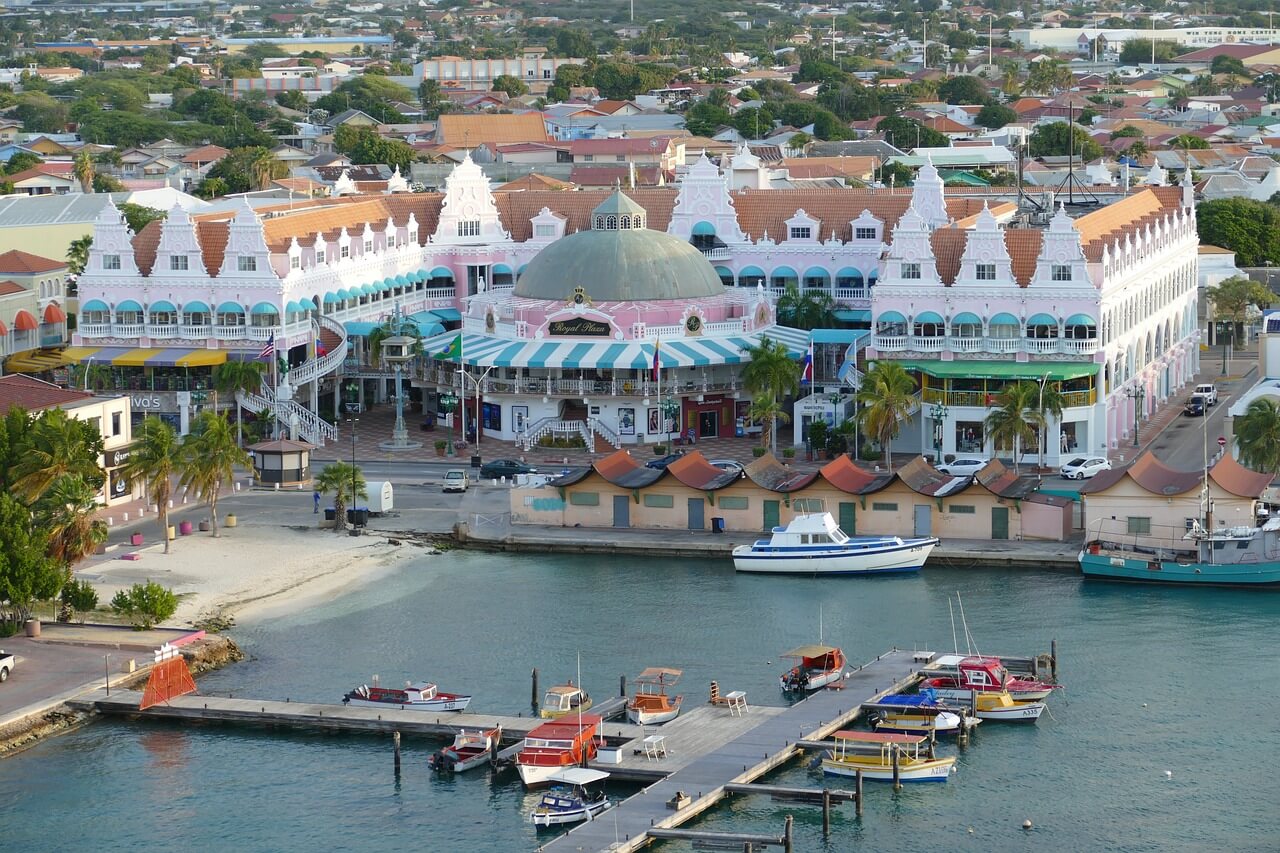When to visit Aruba during the year?
Aruba enjoys a tropical climate, making it a year-round destination. The peak tourist season runs from mid-December to mid-April, coinciding with the dry season, when sunny skies and warm temperatures attract visitors seeking to escape colder climates. During these months, popular activities include lounging on pristine beaches like Eagle Beach and Oranjestad, as well as participating in water sports such as snorkeling and diving. Summer months, from June to August, also see an increase in tourism, particularly from families. Autumn is quieter, with fewer tourists, although November still offers pleasant weather and vibrant local events. Average temperatures typically range from 78°F (25°C) in winter to 88°F (31°C) in summer.
How to get to Aruba?
Aruba is accessible via multiple transportation methods, primarily through air travel. The island is well-connected by international flights from various continents, making it convenient for global travelers.
- Main airport: Queen Beatrix International Airport (AUA), connecting key international cities.
- Major international routes include:
- From North America: New York (JFK), Miami (MIA), and Atlanta (ATL).
- From Europe: Amsterdam (AMS) and London (LGW).
- From South America: Bogotá (BOG) and Caracas (CCS).
- From Asia: Tokyo (NRT) usually requires connecting flights through major hubs.
- Low-cost airlines: Spirit Airlines, JetBlue, and Southwest are popular for travelers from the U.S.
- Flight times: Approximately 4 hours from Miami, 10 hours from Amsterdam, and 6 hours from New York.
- There are no international bus services directly to Aruba; however, inter-island ferries do connect with nearby islands.
- Aruba does not have a rail network due to its small size and isolated location.
- Driving to Aruba is not possible since it's an island; however, rental cars are available upon arrival.
- Main roads are well-maintained with options for driving around the island.
Tourist activities in Aruba
Aruba is a playground for both adventure seekers and those looking to relax. With its stunning beaches and vibrant culture, there's something for everyone. Here’s what you can enjoy:
- Water Activities: Dive into clear waters teeming with marine life at sites like the Antilla shipwreck or enjoy windsurfing at Hadicurari Beach.
- Land Adventures: Explore Arikok National Park, where you can hike through rugged landscapes dotted with indigenous wildlife.
- Cultural Experiences: Visit the capital, Oranjestad, to appreciate its colorful architecture and local markets.
Beyond these, don’t forget to join in on local festivities like the Carnival, celebrated with parades and music in January-February, and savor unique colonial heritage evident in island landmarks.
Accommodation in Aruba
Accommodations in Aruba vary to suit different preferences and budgets. Whether you fancy luxury resorts, boutique hotels, or family-friendly apartments, there’s plenty on offer.
- Luxury Resorts: The Palm Beach area is known for high-end resorts like the Ritz-Carlton and Marriott, typically ranging from $300 to $600 per night.
- Mid-range Hotels: Options like the Holiday Inn or Divi Resort provide great amenities at about $150 to $250 per night.
- Budget Accommodations: Hostels and guesthouses offer stays for as little as $50 to $100 per night, ideal for backpackers.
Prices fluctuate seasonally, with higher costs during peak tourist months. Booking in advance can often yield discounts and better availability.
Food in Aruba
Aruban cuisine is a delightful melange of Caribbean, Dutch, and Latin influences. Must-try dishes include keshi yena (stuffed cheese) and pan bati (cornmeal pancakes). Fresh seafood is prevalent, with catch-of-the-day specials often available at local restaurants.
Don’t miss street food like pastechi (savory pastries) from food vendors. Average meal prices vary, with local dining around $15-$30 per person and high-end restaurants ranging from $40 upwards.
Popular dining spots like Zeerover offer a casual atmosphere and are known for their fresh catch and excellent views.
Important numbers and information
- Emergency Services: Police - 911, Ambulance - 911, Fire Brigade - 911
- Embassy Contacts: U.S. Embassy in Aruba: +297 583 4400
- Airports: Queen Beatrix International Airport, L.G. Smith Blvd, Oranjestad, Aruba
- Currency: Aruban Florin (AWG). Major credit cards are widely accepted.
- Visa Requirements: Visitors from many countries, including the U.S. and EU, do not require a visa for stays up to 30 days.
What to see in Aruba?
Aruba is rich in attractions, both natural and historical. Among the must-see sites are:
- Oranjestad: The capital, known for its colorful architecture and bustling shopping areas like Palm Beach Plaza.
- Arikok National Park: A vast natural reserve featuring unique desert landscapes and indigenous wildlife.
- Natural Pool: A secluded swimming hole surrounded by rocks, perfect for swimming and exploring.
- California Lighthouse: An iconic landmark with panoramic views of the coastline.
- Baby Beach: Notable for its tranquil water, making it a favorite for families.
These sites showcase the island’s unmatched beauty and heritage, making them well worth a visit.
History, geography and climate
Aruba, part of the Lesser Antilles, has a rich history influenced by native Arawaks, European colonization, and African slaves. Gaining independence from the Netherlands in 1986, it continues to embrace its multicultural identity.
The island is primarily flat, with its highest point at Mount Jamanota reaching only 188 meters. Arid landscapes prevail, complemented by stunning beaches and coral reefs. Aruba enjoys a tropical climate characterized by warm temperatures year-round, averaging 82°F (28°C), with a dry season from January to September and a slightly wetter climate from October to December.
Population and culture
With a population of about 110,000, Aruba is a melting pot of cultures, including Dutch, Latino, and indigenous influences. The official languages are Dutch and Papiamento, fostering a unique blend of customs and communication.
The predominant religion is Christianity, with notable celebrations around Easter and Christmas. Additionally, the island hosts vibrant events like Carnival, deeply rooted in Aruban tradition and showcasing colorful parades and music.
Arubans are known for their friendliness and warm hospitality, making visitors feel welcome and appreciated during their stay.








